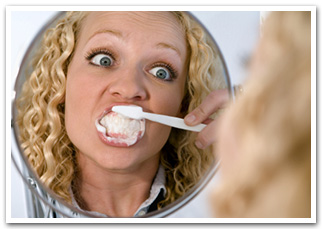Hi everyone!
I love the fact that with every new published study, we learn how to keep our teeth and gums healthier. Now, a recent study from the Academy of General Dentistry reveals the best times to brush for better oral health.
teeth and gums healthier. Now, a recent study from the Academy of General Dentistry reveals the best times to brush for better oral health.
Traditional dental hygiene has always advocated that immediately brushing after eating sweets or a meal is the best way to avoid feeding the plaque and bacteria on our teeth, especially if that sweet treat is sticky or in a liquid form. But many of these substances we eat every day are not only high in sugar but high in acid. It also seems that what we eat can guide us when choosing an optimal time to brush and rinse.
Nothing is More American than a Cold, Icy Soda
A recent Gallup poll from Huffington Post shows that almost half of all Americans drink soda on a daily basis; that’s at least 2.6 cups a day. That’s 45 gallons of soda each year per person. Not only are most sodas very acidic, so are sports drinks and wine. While it may seem I’m just another dentist picking on the soda industry, just remember that citrus foods and juices are also high in acid. So if you have like to suck on lemon or lime slices, you’re actually bathing your teeth in a strong acid. (My mother-in-law needed all of her teeth restored due to erosion from lemons.)
Of course, we’re not advocating that you quit your favorite soda, but we are here to suggest that you rinse after consuming high-acid foods or wait at least 30 minutes to brush your teeth. A 2004 study published in the journal General Dentistry suggests that brushing your teeth immediately after consuming a high-acidic food or drink may be the equivalent to scrubbing with an abrasive substance, much like using an acid to make etchings on a smooth glass surface. Acid weakens the surface of tooth enamel making it more prone to erosion from simple brushing.
It’s about the pH Levels
Whenever you eat or drink something acidic the pH level of your mouth goes down. The ideal pH level is neutral (7), and when you drink a soda or even a diet soda, which has a pH level of about 2.5, it will take some time for the mouth’s pH level to neutralize.
A quick rinse with plain H2O, can help bring your mouth’s pH level back to normal more quickly. If rinsing is out of the question, chewing sugarless gum is a good alternative. It is important to note that xylitol, a sweetener in some sugarless gums, has characteristics that prevent bacteria and plaque from sticking to tooth enamel and producing acids. This actively results in decay prevention, but you need to chew a fair amount of xylitol gum to get results (5 grams), and you need to use it at least 5 times per day. Look for products with 100% xylitol. See http://www.xylitol.org/xylitol-products for a list of recommended xylitol products.
Cheese, Please!
Speaking of wine, when you pair that glass of vino with a chewy cheese you will naturally prevent the acid erosion caused by the wine and encourage the remineralization of your teeth. So a wine and cheese pairing turns out to be a good thing, since the cheese, depending upon its texture, can actually counteract the acidity found in the wine. In reality, any chewy food without sugar can stimulate saliva flow, washing away harmful bacteria and plaque and buffering (diluting) the harmful acids.
It’s our pleasure at Dr. Mark Langberg’s Southfield, MI office to answer any questions you have about your daily dental regimen. After all, we make it our business to keep your teeth and gums healthy. Feel free to call us at 248-356-8790 and let us help you keep worry-free, pain-free and that smile of yours beautiful for years to come.
Until Next Time,
Mark W Langberg, DDS, MAGD
Your Southfield Family Dentist
Tel: (248) 356-8790
